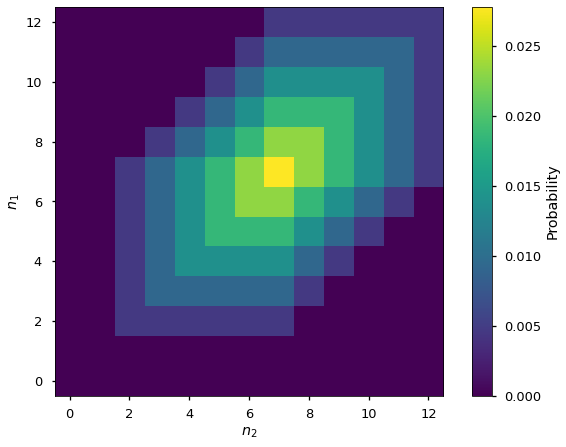Multivariate probability generating functions#
While one can go a long way with univariate generating functions, it is limited to characterize a single random variable—or the sum of multiple independent random variables—, but to characterize \(m\) random variables \((n_1, n_2, \dots, n_m)\) that are not necessarily independent, we need to consider multivariate probability generating functions of the form
where \(p_{n_1,n_2,\dots,n_m}\) is the joint probability distribution.
Fortunately, all the properties we discussed previously and the numerical inversion can still be applied.
Playing craps the hard way#
In a regular game of scraps, the goal is to predict the outcome of a roll of two six-sided dice. But we care about each die and not just the sum of their results! For instance, rolling a 4, 6, 8, or 10 as both dice giving the same number is called a “hard number,” because it’s rolled the “hard way”. Our previous approach to rolling two dice would simply sum their results and generate the outcome with \(g_6(x)^2\) such that a 4 and a 2 is the same as two 3s! How can we calculate the probability of rolling a 6 the hard way? We keep track of each outcome independently!
So what is the probability of a 6 the hard way? It is generated by the following PGF and associated with its \(x_3^2\) coefficient since it involves 2 rolls of 3.
Throwing dice of different colors#
Let’s assume we throw three fair dice. Two of the three are blue and one is red (call this one a bonus). We calculate two sums (\(n_1\) and \(n_2\)) by adding the number on top of the red die with the two numbers on top of the blue dice independently. So, if the red die reads 2 while the blue dice read 4 and 5, we get two numbers by adding our bonus to the two blue dice: \(n_1=4+2=6\) and \(n_2=5+2=7\). What is the PGF for \(p_{n_1,n_2}\)? It is
Indeed, if \(k_1\) and \(k_2\) are the number on top of the blue dice, and \(k_3\) is the result on top of the red die,
So, despite the fact that \(n_1\) and \(n_2\) are not independent, we can still use the independence of the underlying dice throw (\(k_1\),\(k_2\), and \(k_3\)) to construct the joint PGF by the multiplication of the PGFs representing the independent random variables.
Numerical inversion of multivariate PGFs#
Similarly to the univariate case, the joint distribution \(p_{n_1,n_2}\) is recovered from the multivariate PGF \(G(x_1,x_2)\) using a discrete Fourier transform
Again, \(r_1\) and \(r_2\) are the radii of the contour of integration in both dimensions and should be chosen wisely to limit the effect of aliasing if \(N_1\) and \(N_2\) are too small.
import numpy as np
import matplotlib.pyplot as plt
plt.style.use(['seaborn-talk'])
g = lambda x: np.sum([x**n/6 for n in range(1,7)])
G = lambda x1,x2: g(x1)*g(x2)*g(x1*x2)
G = np.vectorize(G)
N1 = 13
N2 = 13
n1 = np.arange(N1)
n2 = np.arange(N2)
c1 = np.exp(2*np.pi*1j*n1/N1)
c2 = np.exp(2*np.pi*1j*n2/N2)
C1, C2 = np.meshgrid(c1, c2) #get 2d array versions
pn1n2 = abs(np.fft.fft2(G(C1,C2))/(N1*N2))
plt.imshow(pn1n2, origin='lower')
plt.colorbar(label='Probability')
plt.ylabel(r'$n_1$')
plt.xlabel(r'$n_2$')
plt.show()

Try playing with both the dimensions (\(N_1,N_2\)) and the radii (\(r_1,r_2\)) to see the impact.

